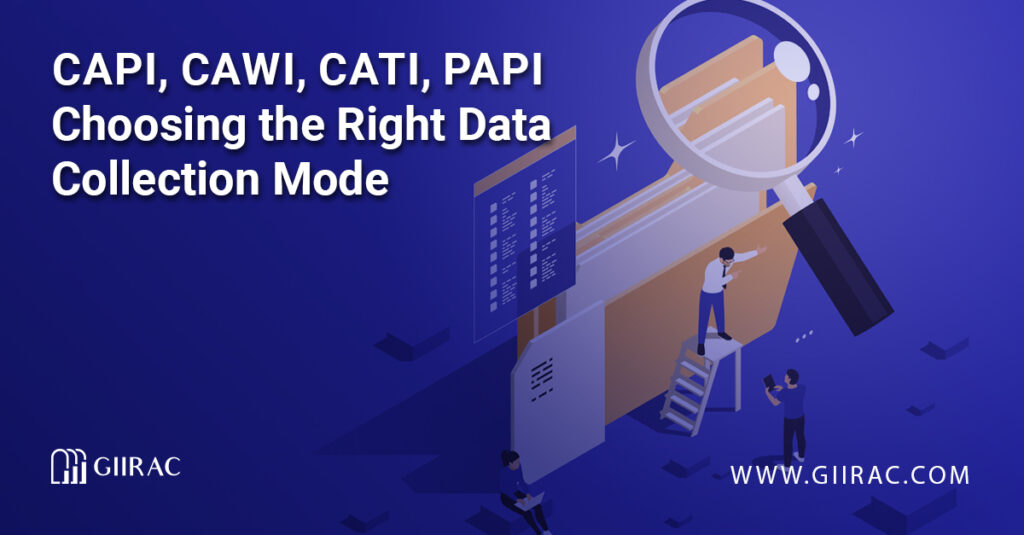Research teams have several ways to collect survey data. The four main modes—Computer-Assisted Personal Interviewing (CAPI), Computer-Assisted Web Interviewing (CAWI), Computer-Assisted Telephone Interviewing (CATI), and Paper-and-Paper Interviewing (PAPI)—each involve different procedures, tools, and environments. Each mode has trade-offs in cost, speed, data quality, and reach, and the best choice depends on context. For example, online surveys are typically less costly than phone surveys, while face-to-face CAPI can handle longer, more complex interviews than phone calls. In practice, survey planners weigh factors like technology access, cultural norms, and security. In challenging environments such as Iraq—with uneven electricity, intermittent Internet, and diverse languages—these factors strongly affect which mode works best.
Computer-Assisted Personal Interviewing (CAPI)
CAPI is a face-to-face interview mode in which an interviewer uses a mobile device (tablet, smartphone, or laptop) to administer the survey and directly record answers. The technology allows automatic question routing and real-time data entry. Key characteristics of CAPI include: an interviewer guides the respondent through a digital questionnaire, and the system enforces skip logic and validation rules. Because the interview is personal, the interviewer can clarify questions or probe answers, making CAPI suitable for long or complex surveys.

- Pros: CAPI can ensure high-quality data by automatically applying skip patterns, logic checks, and range validations during the interview. This catches errors on the spot and reduces later data cleaning. The device can capture non-verbal cues (tone, gestures) and even audio or photos if needed, enriching the data. GPS stamping and timestamps enable supervisors to verify that interviews took place as planned. There’s no separate data-entry step: responses go straight into digital form. Because the interviewer controls the device, very long questionnaires (45+ minutes) are feasible.
- Cons: CAPI is relatively expensive and logistically complex. It requires buying and maintaining devices, plus training interviewers in both survey methods and technology. Insecurity is a big concern: interviewers carrying expensive tablets can be targets in high-crime or conflict areas. CAPI also depends on battery power and (optionally) network connectivity. In remote areas of Iraq, power cuts are frequent, and if data cannot be uploaded or backed up, it can be lost. Also, CAPI is less flexible for unplanned questionnaire changes on the fly, and respondents worried about data privacy may feel uneasy entering answers on a device. Because it is interviewer-led, CAPI typically takes more time per interview than self-administered surveys.
Use case – Iraq: In an Iraqi household survey (e.g. on agriculture), teams often chose CAPI to handle a long questionnaire. In cities like Baghdad and Erbil, where power and connectivity exist, field supervisors loaded questionnaires on tablets, enabling instant validation and data upload. For example, a survey of healthcare workers in Basra found that enumerators could cover 50 questions with skip logic quickly on tablets. However, in rural or unstable areas (e.g. parts of Diyala or Anbar), survey managers had to send extra battery packs and sometimes switch to paper, because trucks with devices faced vehicle checkpoints and theft risk. In one case, a Basra field team kept paper backups of key questions in case devices failed.
Computer-Assisted Web Interviewing (CAWI)
CAWI is self-administered online surveying. Respondents receive a link or invitation and complete the questionnaire on their own computer, tablet, or smartphone. The survey uses a web form or app, so questions can include images, audio, or video, and smart branching (“skip logic”) is automatic. Because participants fill it in themselves, CAWI eliminates the need for interviewers during data collection. Data go directly into a database, and analysis can begin immediately once the survey closes.

- Pros: CAWI is very cost-efficient for large samples. There are no printing or mailing costs and no interviewer salaries during fieldwork. Survey updates or corrections can be done instantly without reprinting. The web interface allows multimedia and interactive question formats (video prompts, sliders, etc.), which can boost engagement. Responses arrive quickly into a central system, speeding up monitoring and analysis. Because respondents work privately, sensitive questions may get more honest answers.
- Cons: CAWI’s major limitation is reach. Not everyone in Iraq has reliable Internet or owns a device, especially in rural areas and among older or poorer populations. Internet coverage is uneven: nationwide only about 50–82% of Iraqis are online, and the country frequently suffers intentional shutdowns (66 separate outages in 2023 alone). Network speeds can be slow, and power cuts interrupt connectivity. Moreover, online samples tend to skew young, educated, and urban. In regions or segments with low literacy (for example, older rural women in central Iraq) or where English-based software interfaces are not understood, CAWI yields biased or incomplete data. Finally, without an interviewer present, questions can be misunderstood and respondents can drop out part-way, reducing completion rates.
Use case – Iraq: CAWI can work for surveys targeting urban, tech-savvy groups. For instance, a consumer goods firm in Baghdad once ran an online survey about smartphones. The firm sent SMS invitations to mobile subscribers (who pay for Internet data), and many younger city residents completed the web questionnaire. This approach was far cheaper than hiring dozens of interviewers. However, during an exam period in late 2023, an internet shutdown blocked online access for a day. The researchers quickly pivoted: they allowed respondents to fill the form offline (CAPI-style) and used CATI follow-ups to capture key items from those interrupted by the blackout. This mixed-mode adjustment highlighted CAWI’s vulnerability to local disruptions.
Computer-Assisted Telephone Interviewing (CATI)
CATI uses telephone calls to administer surveys, with each interviewer following a script on a computer screen. Unlike pure phone calls, the questionnaire logic (skips, branching) is built into the software. Interviewers read questions to respondents over the phone and type answers into the system. CATI platforms also handle sample management, call scheduling, and real-time monitoring of progress and quotas.

- Pros: CATI is generally faster and cheaper than face-to-face. Because data entry is simultaneous with interviewing, there’s no separate data-entry step, greatly reducing transcription errors. Survey teams can cover a wide geographic area from a centralized call center. Call outcomes (completed, no answer, refusal) are tracked in real time. Live call data allows supervisors to re-assign interviewers or adjust quotas as needed. Interviewers can clarify questions verbally, which can improve comprehension compared to self-administered surveys. Modern CATI software can be combined with online surveys: for example, a respondent might be offered a web link after initial phone contact, maximizing overall participation.
- Cons: The telephone mode has its limits. Creating and testing the CATI program takes time before fieldwork, especially for complex questionnaires. Handling open-ended questions is harder: interviewers must type fast, and nuanced answers may be lost. Changing a previous answer mid-call is tricky on some systems, which can frustrate respondents. Crucially, CATI coverage depends on phone access. In Iraq, fixed landline use is very low (roughly 5–6 lines per 100 people) and declining, so most calls must be to mobile numbers. Calling mobile numbers is subject to regulations (for example, auto-dialers are often banned) and many people screen unknown numbers. These issues can lower response rates.
Use case – Iraq: CATI suits surveys where researchers have reliable phone lists. For example, a market research team surveying commercial bank managers in Basra used CATI in 2024. The managers all had mobile lines (remember, Iraq’s mobile penetration is about 90%), so the firm established a call center with local interviewers. The interviewers followed CATI scripts (in Arabic or Kurdish) to administer a structured questionnaire. Data flowed directly into the database, enabling supervisors to track progress online. The team still faced some no-answer rates – notably, many women in conservative households did not answer calls from male interviewers, so the firm assigned female staff for those calls. In remote regions with poor reception (e.g. mountainous Kurdistan), CATI reach was spotty, so in that project CATI was supplemented by a brief CAPI survey to those areas.
Paper-and-Pencil Interviewing (PAPI)
PAPI is the traditional approach: respondents give answers on a paper questionnaire. An enumerator (or the respondent) fills a printed form with pen or pencil. Though seen as “old-fashioned,” PAPI remains useful, especially where technology is impractical. Every response is recorded on paper as the primary record.

- Pros: PAPI works anywhere – no electricity, devices, or network needed. It’s especially handy for small-scale studies or pilot surveys where constant updates are made to the questionnaire. Designing a paper form can be very flexible with simple tools (Word, Excel) and doesn’t require programming. Each completed form is a permanent primary record that supervisors can physically verify and sign off on. Because people often find paper concrete and trustworthy, PAPI sometimes yields higher initial response rates than mail or web surveys. Open-ended and qualitative comments are easy to write in a local language or dialect without worrying if the software supports it. Also, in high-security or crime-prone contexts, PAPI can have an advantage: if tablets would be stolen, paper can simply be photocopied and buried as backup.
- Cons: The major drawback is data entry workload. After field collection, answers must be manually entered (or scanned), which is time-consuming and error-prone. Printing, distributing, and retrieving forms adds cost and delay. Complex skip logic is impossible on paper: interviewers must flip pages and track responses manually, which can lead to mistakes. Physically carrying piles of forms is bulky, and forms can be lost, damaged, or illegible. In practice, mailed or self-administered PAPI surveys suffer very low return rates. Even in face-to-face PAPI, some respondents may skip questions or the enumerator may misrecord answers under time pressure. Finally, PAPI typically yields slower turnaround: data may not be available in analysis-ready form until weeks after collection.
Use case – Iraq: PAPI is often the fallback in the most challenging settings. In one fictitious scenario, a nongovernmental survey about agricultural practices in the Makhmur district (a rural, under-served area) used PAPI entirely. Many villages had no electricity and poor cell signal, and some areas were lightly mined from past conflicts. The local research firm trained community members to conduct interviews using simple questionnaires in Arabic and Kurdish. Each team logged responses on paper. The researchers accepted the labor of manual data entry to guarantee coverage. Another example: during early 2024, a small health clinic chain in Mosul used paper forms to gather patient satisfaction, since their clinic rooms had no computers and staff were not computer-literate. Later, data were entered into a simple online tool for analysis. In short, whenever reliability and universal accessibility are paramount (and budgets permit), PAPI remains a viable choice.
Choosing the Right Mode
No single mode is best for every situation. Market researchers pick data collection methods based on interview context, target population, and resources. Key factors include:
- Respondent Access and Technology: Are target respondents online or reachable by phone? In urban Iraq with high smartphone use, CAWI or CATI may reach many people. In remote areas with only sporadic electricity, CAPI or PAPI might be required. Mobile penetration in Iraq is high (around 90%), so CATI can cover broad demographics, but Internet access is less universal.
- Survey Content and Length: Complex questionnaires with many skips or multimedia are easier on CAPI or CAWI (since software handles logic). Very long or sensitive interviews benefit from CAPI’s personal touch. Short, simple polls can often go by CATI or even SMS/interactive voice response if needed.
- Budget and Speed: Online surveys (CAWI) are cheapest and fastest to deploy, but they risk lower response. Face-to-face CAPI has the highest cost (travel, devices) but can yield the richest data. CATI is middle-ground: less travel cost but still requires paying interviewers. PAPI is expensive in labor per interview (data entry) but minimal tech cost.
- Cultural and Language Factors: In conservative communities, female respondents may only speak to female interviewers, affecting mode and staff selection. Languages and literacy matter: if multiple dialects or low literacy prevail, in-person (CAPI/PAPI) with a local enumerator can ensure comprehension. Also, Iraqis may view unknown survey phone calls with suspicion, preferring in-person introductions.
- Legal and Security Considerations: As seen in Iraq, authorities may cut Internet unexpectedly (affecting CAWI), or certain regions may be off-limits for fieldwork. Data privacy regulations can also shape mode. For example, if a phone poll is likely to be banned by law, researchers might switch to CAPI or PAPI.
Often, mixed-mode designs are used to balance trade-offs. For instance, a study might start with an online survey and follow up non-respondents by phone (CATI) or in-person (CAPI) to improve coverage. Modern survey platforms support such hybrids. In a Baghdad retail project, researchers began with an email/WhatsApp invitation (CAWI) and then had interviewers make CATI calls to survey those who did not respond, successfully reaching segments offline.
Local Factors in Iraq
In Iraq’s unique environment, these general considerations become even more critical:
- Infrastructure Instability: Power shortages are common. Freedom House reports that electricity may be available only a few hours per day during hot months. Backup generators or batteries are often needed. Unscheduled Internet outages occur frequently (66 shutdowns in 2023), so any web-based data collection must be prepared for interruptions.
- Connectivity and Devices: While mobile phone ownership is very high, not all phones are smartphones or have data plans. Fixed broadband is scarce; only about 50% of Iraqis use the Internet at all, mostly in cities. Many rural areas still use 2G networks. Survey teams should verify local telecom coverage maps before planning CAWI or CATI fieldwork.
- Literacy and Language: Iraq’s literacy rate is around 80–85%, but this masks gender gaps. Female literacy was only about 80% as of 2017, and in rural or conservative areas it can be much lower. Surveys requiring reading (online forms, written responses) will systematically exclude some women and older adults. Multi-lingual surveys (Arabic, Kurdish, Turkmen, etc.) may be needed, which is easier in-person than via canned online tools. Local dialects also affect how questions are phrased; only an interviewer can catch subtleties easily.
- Cultural Norms: Personal trust plays a role. In some communities, inviting strangers into a home (CAPI) is acceptable, while in others people might only trust a neighbor or local leader. Phone calls from unknown numbers may be seen as scams, reducing CATI success. Researchers often need local “gatekeepers” to introduce a study. Working with experienced local field managers helps navigate these norms.
Given these realities, expert guidance is invaluable. Seasoned Iraqi research firms understand, for example, that a telecom sector study in Erbil might lean heavily on CAWI (given high 4G uptake), whereas a nutrition survey in rural Diyala might rely on CAPI/PAPI with local interviewers. Tailoring the mode to the region and audience – drawing on institutional knowledge like that of JIRAC’s research teams – helps ensure good response and reliable data.
Illustrative Example Scenarios
- Retail Study in Baghdad vs. Kirkuk: A hypothetical grocery chain wants to assess consumer awareness of a new product. In Baghdad’s urban neighborhoods, many shoppers have smartphones and use Facebook and WhatsApp, so the team runs an online CAWI survey and advertises it on social media and SMS. Initial results come fast, and the cheap cost allows a large sample. In Kirkuk’s outskirts, however, Internet is less reliable and many older customers have basic phones or no data. The team supplements with CATI calls using regional language interviewers, and even sent some field agents with tablets to local markets (CAPI) on weekends. By mixing modes, the brand reaches both tech-savvy and traditional customers.
- Healthcare Survey in Erbil: An NGO monitors vaccination rates. They chose CAPI because their questionnaire is long and technical. Kurdish-speaking interviewers visit households with tablets. The tablets’ GPS confirms visits. They rely on offline data collection (syncing later) due to spotty home Internet. In busy clinics, nurses also help administer a short PAPI exit survey on tablets with older software. The combination of methods – face-to-face home interviews and quick clinic surveys – covers both the general population and urban clinic-goers.
- Political Polling in Basra: A polling firm needs opinions on local governance. They try CATI using a voter phone list. Many respondents answer and provide useful data, but some say they distrust unsolicited calls. Later, the firm adds a small PAPI component: local community volunteers drop paper questionnaires to homes in a Basra neighborhood, then collect them the next day. The in-person aspect increases participation among skeptical residents. Together, CATI and PAPI give a fuller picture than either alone.
- Education Research in Sulaymaniyah: Researchers studying Internet use among youth distribute a CAWI survey via university mailing lists and Facebook. They get responses from hundreds of students quickly. However, they notice very few responses from female students, some of whom informally report that their families limit their computer access. Recognizing the gap, the research team also sets up a brief in-class PAPI survey in a women’s college class (with university permission). This in-person approach captures additional perspectives that CAWI alone missed.
In each case, local conditions dictated the mix. Iraq’s combination of high mobile use but unpredictable infrastructure means that savvy researchers rarely rely on a single mode. Instead, they choose the primary mode suited to their audience and keep a backup plan ready (for example, preparing paper forms in case a planned CAWI gets interrupted).
Conclusion
Each data collection mode has its place. CAPI excels at rich, high-quality face-to-face interviews but requires more resources; CAWI is fast and cheap but depends on respondents’ connectivity and comfort with technology; CATI bridges the gap by reaching mobile phone users with moderate cost; and PAPI remains indispensable where none of the above are feasible. The optimal choice depends on the project goals, the targeted population, and the local environment. In Iraq, factors like electrical reliability, Internet stability, literacy, and culture heavily influence what works best. Ultimately, informed judgment – grounded in experience and local insight – guides the decision. Seasoned research institutions (for example, those with deep on-the-ground knowledge like GIIRAC) can draw on past projects in the region to advise which mode (or combination of modes) will yield the most complete and accurate data under the given conditions.

